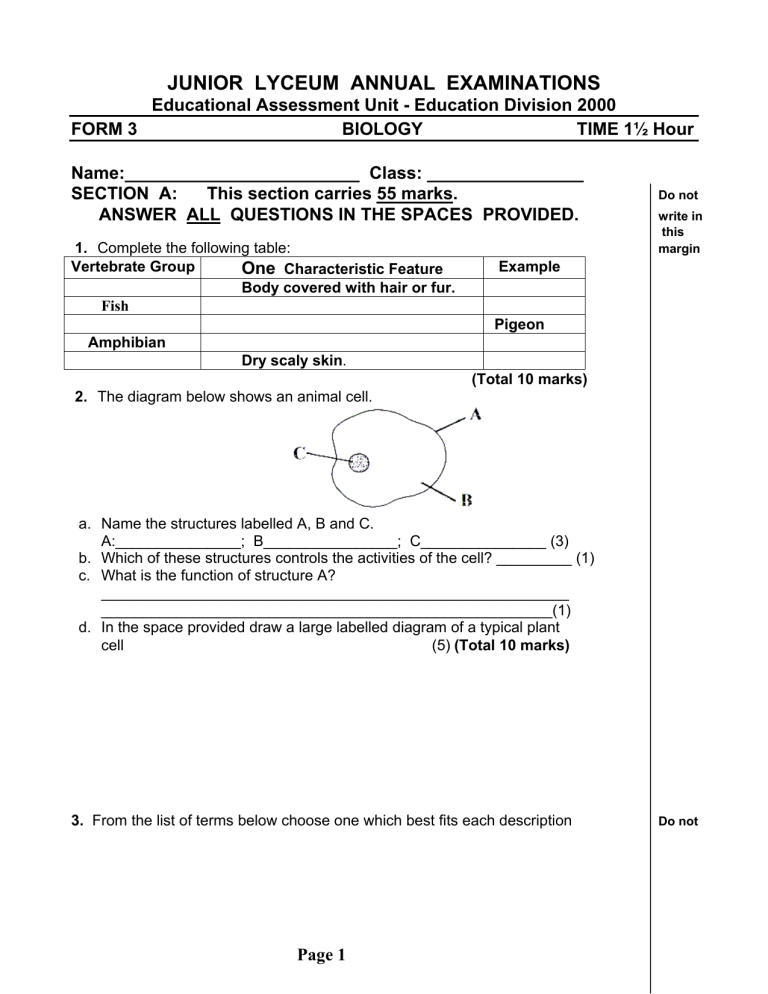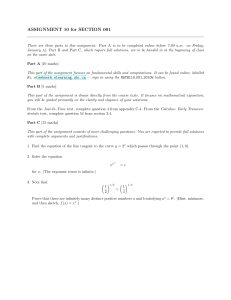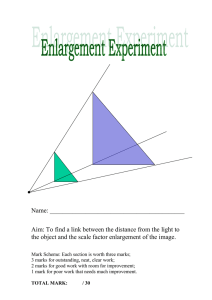
JUNIOR LYCEUM ANNUAL EXAMINATIONS Educational Assessment Unit - Education Division 2000 FORM 3 BIOLOGY TIME 1½ Hour Name:________________________ Class: ________________ SECTION A: This section carries 55 marks. ANSWER ALL QUESTIONS IN THE SPACES PROVIDED. 1. Complete the following table: Vertebrate Group One Characteristic Feature Body covered with hair or fur. Fish Do not write in this margin Example Pigeon Amphibian Dry scaly skin. (Total 10 marks) 2. The diagram below shows an animal cell. a. Name the structures labelled A, B and C. A:_______________; B________________; C_______________ (3) b. Which of these structures controls the activities of the cell? _________ (1) c. What is the function of structure A? ________________________________________________________ ______________________________________________________(1) d. In the space provided draw a large labelled diagram of a typical plant cell (5) (Total 10 marks) 3. From the list of terms below choose one which best fits each description Page 1 Do not in the table. Abiotic factors Biotic factors Parasitism Mutualism Predator TERM DESCRIPTION The influence that one organism has on other organisms and their environment. A relationship between two species from which both partners get some benefit. A carnivore that feeds on another animal which is known as the prey. The physical environment e.g. light intensity and Oxygen. Relationship between two species in which one gets food and shelter from the other while causing some degree of harm to it – perhaps eventually killing it. (Total 5 marks) 4. This potometer was used by some biology students to demonstrate the rate of water movement through a leafy shoot. write in this margin a. Name the process by which the plant loses the water through its leaves. _________________________________________________________(1) b. State three environmental conditions which affect the rate of movement of water through the plant. (i)_________________ (ii)_________________(iii)______________(3) c. One of the readings showed that the time taken for the water to move 100 mm was 2 minutes. Calculate the rate of water movement in mm per minute (Show your working) ________________________________________________________ __________________________________________(2) (Total 6 marks) 5. a) Name two functions of the root: Do not i)___________________________________________________________ write in ii)_________________________________________________________(2) this Page 2 . b) In the space provided draw a labelled diagram of a transverse section of a dicot root. Label the xylem and phloem (vascular bundles) (4) (Total 6 marks) 6 Put the following terms in order of size (smallest first) phylum; order; kingdom; class; family. __________ Smallest __________ Largest (Total 5 marks) 7. Find the surface area to volume ratio of the following cube of sides 2 cms. (Show your working) Surface Area = _______________________ _______________________(2) Volume = _______________________ _______________________(2) Surface Area to Volume ratio = ____________(1) (Total 5 marks) 8. Match organisms in column A with phyla in column B and characteristics in column C. The first one is done for you as an example. A B C 1. snail a. annelid i) tentacles with stinging cells 2. jellyfish b. mollusc ii jointed limbs with exoskeleton 3. earthworm c. coelenterate iii) soft – bodied with shells 4. spider d. echinoderm iv) marine and spiny- skinned 5. starfish e. arthropod v) segmented worm RESULT: 1. Snail 2. Jellyfish 3. Earthworm 4. Spider 5. Starfish ( b ; iii ) __________ ( ; ) __________ ( ; __________ ) ( ; ) ( ; ) (Total 8 marks) SECTION B : Answer your questions on the papers provided. This Section carries 45 marks. Answer Question ONE and any other TWO questions . Question 1. Read the following paragraph and answer the questions below: Page 3 margin In 1665, an English scientist named Robert Hooke (1665-1703) used a microscope to investigate the structure of a very thin sheet of cork. He discovered that it had tiny compartments in it. He thought of them as rooms and called them ‘cells’, after the small rooms in monasteries where monks worked and meditated. (i) Why are microscopes very useful in Biology? (1) (ii) Describe briefly how you would use the microscope to observe a prepared slide: (a) under low power (b) under high power . (2,2) (iii) “Division of labour” is another concept that you have studied in Biology. Put the following in order of size largest first. (4) Organ; cell; system; tissue (iv) Define (a) tissue (b) organ (1,1) (v) During a Biology practical, you were asked to use the microscope to observe a prepared slide showing the internal cellular structure of the leaf. Draw a large labelled diagram to show the internal cellular structure of the leaf. (4) (Total 15 marks) 2. a. Describe briefly the composition of soil. (3) b. State three differences between sandy and clay soil. (3) c. ‘Earthworms have a beneficial effect on soil’. Describe this statement. (4) d. You are given three different samples of soil: one labelled ‘clay soil’, one labelled ‘sandy soil’ and the other labelled ‘ loam soil’. Describe an experiment to find out which of these has the best water retaining abilities. (5) (Total 15 marks) 3. a. List three characteristic features of ‘insects’ (3) b. Insecticides are chemicals that kill insects. Biological pest control is an alternative. Write notes on ‘Biological pest control’. In your answer make reference to (i) the pest controlled, (ii) the harm done and (iii) how it is controlled. (1,1,1) c. Insects can be harmful or beneficial. (i) Name two insects. Common or scientific names are accepted. (2) (ii) Name one harmful (detrimental) and one beneficial activity of insects. Your answer should not include Biological pest control. (1,1) d. Draw a labelled diagram of a named common insect-pollinated flower. (5) (Total 15 marks) 4. a. State two functions of (I) leaves, (ii) stems (2,2) b. Draw a labelled diagram to show a transverse section through the stem. In your diagram label the xylem and phloem (the vascular system) (4) c. Describe the term “ positive phototropism of stems”. (2) d. Using a clinostat, plan an experiment to show that stems are positive phototropic (5) (Total 15 marks) 5. a. ‘Bacteria is an example of a prokaryotic cell’. Describe this statement. (2) b. State two differences between viruses and bacteria. (2) c. Draw large labelled diagrams to show the outline structure of: (i) a typical bacterium (ii) a typical virus (iii) a named fungus (3,3,3) d. Describe briefly the saprophytic mode of nutrition (extra-cellular digestion) of the named fungus. (2) (Total 15 marks) Page 4 Page 5





